California produces approximately 90% of all wine produced in the United States[1]. Many wines are aged in oak barrels, as the oak imparts desirable buttery, or vanilla, flavors to the wine. New barrels impart more flavor to wines than old barrels, and depending on the wine, and the winemaker, some barrels may only be used for 2-3 years before they are permanently retired.
We’re situated within the Santa Cruz Mountains American Viticultural Area. As such there’s no shortage of wineries here, or surplus wine barrels that are no longer of use to winemakers.
Last summer we picked up a couple of lightly used French Oak barrels from a local winery. Old wine barrels can be used for a multitude of purposes, and our original intention was to use them as part of a rain barrel project for the garden.
We brought the barrels home, and while working on other projects, we left the barrels outside for a year, where the oak gradually aged in the sun and rain, and the wood shrunk, and weathered to a drab grey color. After the greenhouse was finally in position though, we decided it really was time to put the barrels to use.
As the barrels were now too dry and permeable to be used for a rain barrel, over the weekend, using a circular saw, we split one barrel in half, to make two individual half-barrel planters.
Although the weathered grey color of the oak was attractive in its own right, it didn’t really fit with the redwood raised planters in this part of the garden, or the newly installed redwood greenhouse, so we used a tinted water-based stain to breathe a little life back in to the barrels, and help them to resist the elements over the coming winter months.
Once the stain had dried, using a 7/8 inch spade bit, three holes were drilled in the bottom of the barrels to improve drainage, before filling the barrels with a compost amended soil.
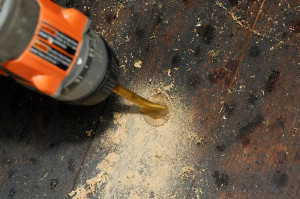
We drilled drainage holes in each barrel. Note the raindrops on the wood...RAIN!...It actually tried to rain on us...in September!
The next challenge was deciding what to plant. My intention, next spring, will be to fill at least one of the barrel planters with an assortment of oregano, thyme, and mint, primarily to contain the mint so it doesn’t run amok all over the gardens.
However, most of the herbs are winding down now that it’s late summer, so instead, for now, as flowers are few and far between in the native garden areas at the moment, we decided to plant a diversity of flowers, to attract a variety of pollinators to this part of the garden.
One of the most notable plants blooming in area garden centers at the moment, is Rudbeckia hirta. I admit, for some time I’ve been quite envious of Gail’s collection of Rudbeckias in her garden, and the plethora of pollinators that visit them. However, as most of our garden area here is devoted to California native plants, we had avoided planting Rudbeckia, until now. The barrels seemed like a perfect place to plant these flowers though, without the risk of them taking over the garden, or outcompeting our native plantings. As a late season bloomer, Rudbeckia will provide a much welcome splash of color amidst the browns of spent native grasses and perennials, and the greens of the established trees surrounding the garden.
These flowers are also a good pollen source for the bees.
Each barrel was planted with Rudbeckia hirta ‘Prairie Sun’, generally grown more as an annual than perennial, so we’ll have to see how well they survive the winter here.
Alongside these vibrant orange-yellow blooms, we also planted a short-flowered honey bee-friendly Salvia longispicata x farinacea ‘Mystic Spires Blue’ for a contrast in color. Note that it didn’t take long for either the honey bees…
…or the Carpenter Bees to find them!
A low-growing Mediterranean native, Asteriscus maritmus ‘Gold Coin’, was planted toward the front of the barrel, complementing the yellow hue of the Rudbeckia, and no sooner was this plant tamped into the soil, than the first Syrphid Flies began to alight on their blooms.
Last but not least, a little Verbena ‘Tapien’, to complement the Salvia, and hopefully cascade down the face of the barrel as it grows. The syrphids also seem to enjoy these blooms, as well as our Woodland Skippers.
So although we didn’t use the barrels for their original intended purpose, while many flowers are fading at the end of summer, we’re hoping this project will keep a little color in the garden as we slide into the shorter days of autumn.
Their new coat of redwood stain helps these barrels to blend in with the existing raised beds in the vegetable garden, and our portable redwood poultry ark.
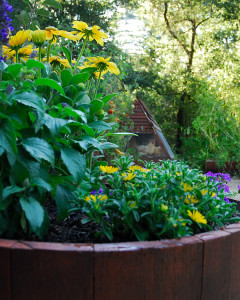
The new stain on the barrels matches the redwood color of our poultry ark that houses our retired hens in the garden
We finished planting out the barrels on Sunday afternoon.
Not typically being much of a container gardener, I have to admit, I’m actually quite impressed with just how much garden life is already attracted to these new planters.
In addition to the bees, hover flies, and butterflies, this morning I found my first Redbacked Jumping Spider (Phiddippus johnsoni) waving at me from a Rudbeckia petal.
A very charming little fellow, who appears to be as excited as we are about these new flowers in the garden.
—————–
[1] California Wine Profile 2010 in California Wine Industry Statistical Highlights. Published by Wine Institute. 2011.

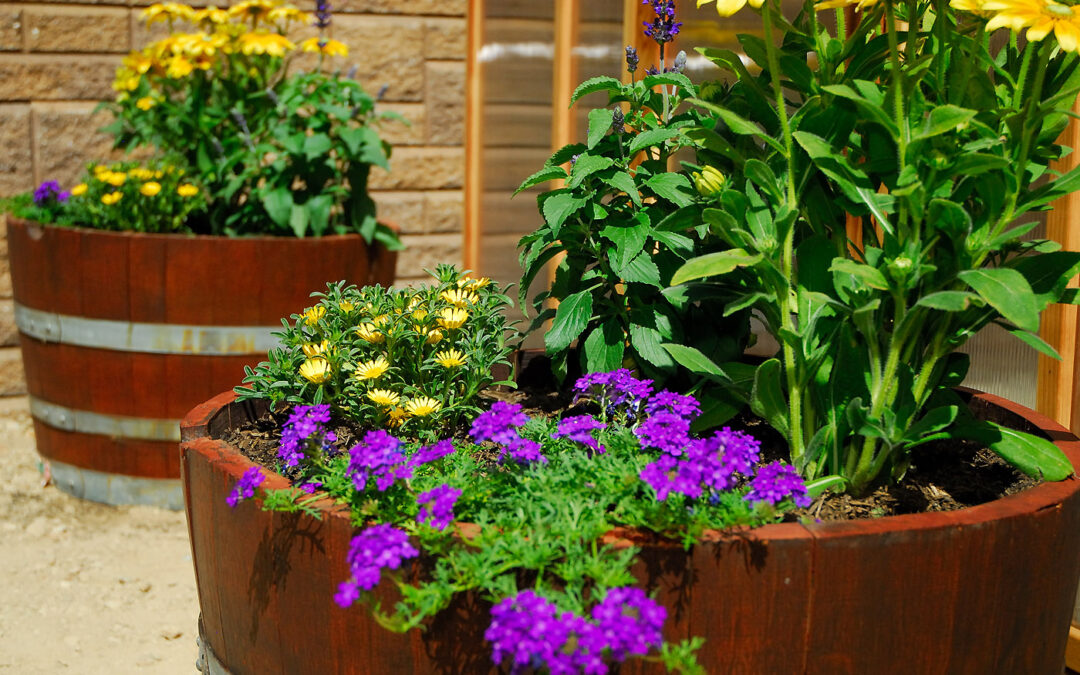
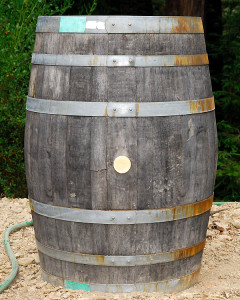

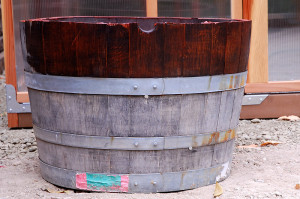

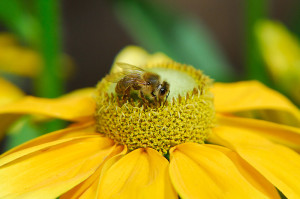
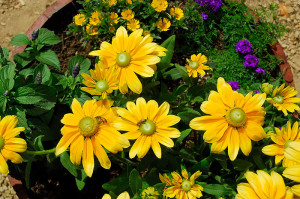
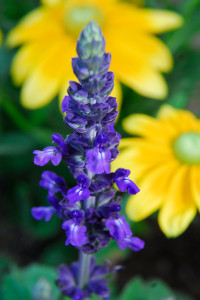
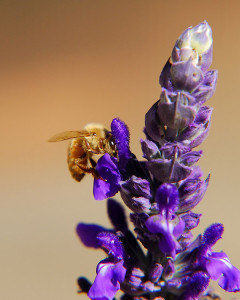
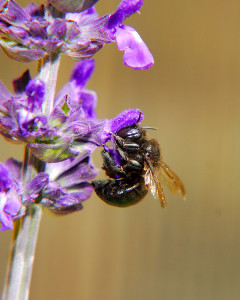
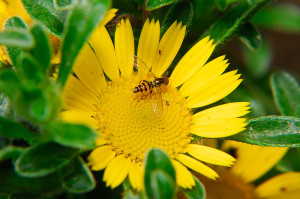
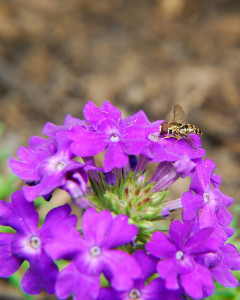

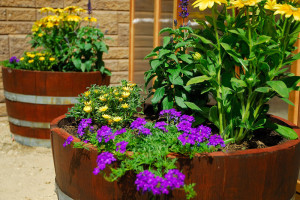
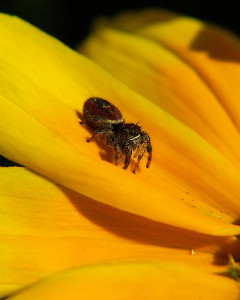








Clare,
Nice barrels, they cost a lot in our parts. Hope your bees are doing well. Had a Chinese Mantis watching from the top of the hive this afternoon.
You raise an interesting point Randy, I hadn’t thought of that. Used wine barrels seem somewhat ubiquitous around these parts, some wineries will even give away some of their older ones here. These were about $20 each (but the barrels were French oak, which is more expensive, and only 3 years old), which isn’t bad, as each one makes two large planters. I suppose it all shakes out though, as granite, and blue stone, cost a fortune out here, and both seem to be everywhere on the east coast 😛
Very nice repurposing of the wine barrels. I don’t have much Rudbeckia in my garden either, just two specimens of a small-flowered one, and one Cherokee Sunset. I love the big yellow flowers on yours! I need more. Next year!
I saw a few Cherokee Sunset at the garden center, and was very tempted, they’re a lovely color. That’s the great thing about gardening…there’s always next year!
I love what you did with the wine barrels. We picked some up years ago at a winery and also planned to use them as rain barrels. For some reason I painted them white then. I love how you stained them, they really look pretty!
I think if we decided to do oak rain barrels, we’d have to get them here, and use them right away, before the barrels completely dry out. Once the wood dries, they leak like crazy! I quite like the stain color too, it goes well with the rust on the metal bands 😛
Your new planters perfectly complement your greenhouse! You will enjoy them for years to come. Well done! P. x
I hope so. Last time I planted one was in our first garden, with a lovely Acer japonicum, and the barrel seemed to hold up very well. Now we have one more barrel left to cut in half, and plant!
Nice reuse of the barrels. They will be nice filled with herbs. NYS has a lot of wine and grapes and I did not realize that CA monopolized the market on wine to such an extent.
I didn’t realize the California wine production was quite that high either. Apparently fourth in production globally after France, Italy, and Spain! I guess us Californians really like our wine! 😛
I love your containers! The plantings are really pretty together. I wish wine barrels were cheaper here, as they look so nice as planters!
Clearly California needs to distribute more barrels, not just wine 😉 I think my first barrels that I planted were Whiskey barrels. I don’t suppose you have a distillery near you instead?
We are lucky indeed in our area to have these wine barrels to use in our gardens – I have one and am tempted to get more too. I get mine ready prepared at probuild nursery, I confess, on River st. I like your cheerful colors. Like you, I like using Inon-invasive) garden plants to add supplemental color, though ight now the madia and lupines are doing a great job giving the garden late summer color. I like the stained look – very dressy!
I used to buy half barrels pre-cut, but I was astonished how much cheaper they are purchased direct from the winery (more fun too, if you get to sample what the barrel was used for 😉 ) My Madia has been done for weeks, although we don’t irrigate ours, it just runs wild where it chooses to grow. Maybe next year I’ll have to try some of the Madia elegans you’ve been growing, and cultivate it on purpose!
Those are really lovely planters, they put character to your greenhouse. I hope they wont rot that fast, as in these parts, most especially because they are always moist, so will succumb fast to molds and bacteria.
The last time I used a half barrel as a planter was for a small Japanese maple, about 20 years ago. The barrel was still in solid shape after we transplanted the maple to the garden some 7 years later. Although that was a whiskey barrel, not a wine barrel, so maybe better preserved from the inside 😉 We’ll see. Even if they don’t last tremendously long, it’s fun to give them new life, and no doubt we can source more down the road.
I really like the photo of the new greenhouse with the planters against the stone wall. The space is really coming together and looks great.
I felt that corner was looking a little austere after the greenhouse went up. We’re anxiously waiting for fall planting, in October, so we can soften the top of the wall with some greenery. With the barrels planted, that part of the garden certainly is looking less sterile, and more cheery!
These are beautiful! I like the color and texture combinations…perfect to flank your greenhouse.
This has been a year for orange/purple, yellow/blue combos in our gardens. A number of our natives fall into that color palette. Although I’m afraid I’m at risk of getting stuck in a rut…might need to mix things up a little in spring 😉
Love your planters! And I really like them stained. They are expensive here – you should be grateful to have a good supply. I love that your wine barrels give a local flavor to your garden. Makes me wonder what’s used around here that I could use in my garden.
I’m certainly more grateful, after hearing from a number of you that they’re not as readily available or affordable. I think living in California for so many years has made me take them for granted. I like the stain too, rather than paint, but in part because I’m hoping it will last longer, and not be prone to peeling as the wood shrinks 😉
Your new planters are great especially since they are recycled. My 13-year-old son has been making and selling containers made out of old logs from our woods–quite beautiful.
There’s a thought, we have more than few of those laying around, and would certainly fit into a woodland garden setting. That’s part of why I liked the barrels, the wood seemed less formal than many ceramic containers, and more appropriate to the space.
Your wine barrels are striking next to the greenhouse. And I couldn’t agree more with your choice of Rudbeckia. We were asked yesterday in our Master Gardener class what plant is our favorite. What a horrible question to ask a gardener, right?! But Rudbeckia is what immediately came to mind. It was a gorgeous bloomer through the heat of our horrible summer and now it’s providing lots of seed for the birds. It’s always faithful.
I think I’ll go have a glass of wine now!
I don’t know why I resisted planting them for so long. My perspective on blooming plants has certainly shifted since we became beekeepers though. I chose these plants in particular because they were the most bee-laden at the garden center. I suppose that means I didn’t really select them, the bees did! I look at flowers completely differently now. Are they the right size/shape for honey bees? Would native bees prefer them? How about hummingbirds? Is it a good nectar source? Pollen source? Does it provide native bee nesting habitat? When does it bloom? Eventually I get around to do I like it, and will the color work in my garden 😉
I love your barrels on either side of the greenhouse. And the flower s you chosen look well together. From looking at national garden pages it sems like the most prolific and widespread choice of flowers, besides roses is Rudbeckia and coneflower.
I hadn’t thought of Rudbeckia as a non-native but I guess it’s sort of on the borderline now. I’ve had cultivars of Rudbeckia and the Gold Coin and both have died some years and overwintered some. I don’t protect anything here by coverings, though. I think you have milder weather than I. In fact there’s thunder and lightning again tonight. 🙂
Well, Rudbeckia hirta is native to some parts of the country. We do have our own native form though, which now I want to source, Rudbeckia californica. It’s not native to the coastal region, but would probably do well where you are. Also a Rudbeckia occidentalis var. occidentalis, that’s native to far northern California. I wouldn’t mind R. californica, if I can find it!
Our coastal climate does tend to be less cold in winter. Here, with our heavy rains, poor drainage tends to cause the demise of plants more than cold. The barrels though should drain very well.
Not being a wine drinker, I’d say you’ve put those barrels to a much better use! And I’m quite sure those happy bees would agree with me. Beautiful addition to your gardens, Clare!
I’m sure if the bees get a little tipsy on flower nectar, that will just make for happy bees 😉
I can spend hours watching your chickens. I just love the Buff Orpingtons – just like my Buffy. I love what you have achieved with your green house and the beautiful barrel pots! Wow!! amazing!
I love the buff orps too. We had such an assortment of chicks last year, but honestly, the buffs are still my favorites. We have some downright mean hens in the newer flock, and there are some breeds I wouldn’t have again because of it. Next time I think we’ll go back to buffs only, although I’m also tempted to go for a flock of Dark Brahmas too, like our rooster, Frodo. 😉
Looking good! I think thats such a great idea… I wish we had wine barrels lying all over the place. But no such luck, I’m sure. There is a vodka plantation nearby….
I love the barrels, and the bees are awesome … and then I saw ‘jumping spiders’ and a cold shiver ran up my spine. (I never thought I had arachnophobia until recently – I’m a big wimp!)